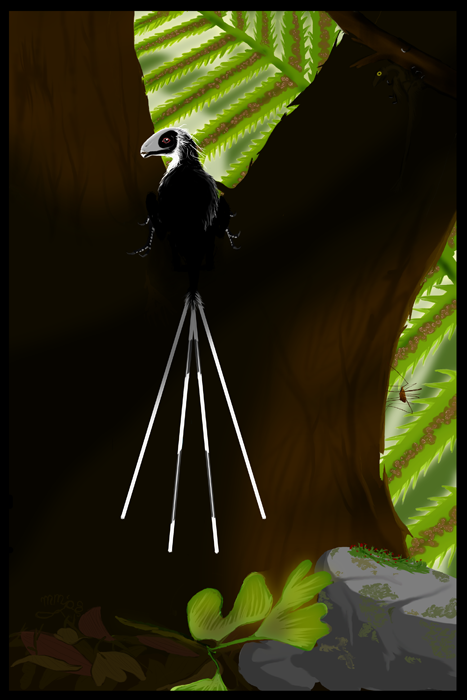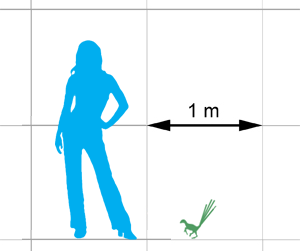home > natural history
Epidexipteryx hui
"Hu's display feather"

click here to buy a print
Described in 2008, Epidexipteryx hui is an unusual, primitive bird (dating possibly to the Middle Jurassic, though the age of its geological formation is disputed) with a unique arrangement of feathers. Currently the smallest known non-avian dinosaur at 25cm, its length was nearly doubled by four ribbon-like tail feathers, known as ETFs (elongated tail feathers) which give it its name. Unlike modern-style feathers which are composed of a central quill and an aerodynamic vane of tiny interlocking fibers ("barbs"), the tail feathers of Epidexipteryx are more simple in structure, retaining the central quill but featuring a solid, ribbon-like vane composed of a single membrane rather than independent barbs. The ETFs were supported by a pygostyle-like structure (the last few tail vertebrae were fused together to give added support), a feature that is appears more and more widespred among primitive birds and their immediate ancestors. Its body was covered in even simpler feathers, composed of hair-like filaments linked together at the base. However, unlike the simple protofeathers covering the bodies of other early birds such as Sinornithosaurus, which have pairs of branching filaments, in Epidexipteryx many filaments appear to arise from a common base, a feature unique among all known dinosaurs and birds.
Another unique feature is the odd, forward-pointing teeth, a characteristic only previously seen in more primitive theropods such as the ceratosaur Masiakasaurus, and in some fish-eating pterosaurs. The front teeth were also especially large, similar to the rabbit-like "buck teeth" of the oviraptoriform Incisivosaurus. Finds like this are helping to confirm an unexpected pattern among maniraptoran dinosaurs (the line leading to and including birds). Long envisioned as mainly carnivorous based on the quintisential dromaeosaurs ("raptors"), it now seems like raptors are the expection to the rule in this group, and that the other families had more diverse diets, eating plants, seeds, and insects as well as meat, and that the ancestors of the carnivorous raptors were likely to have been omnivores. Even the closest relatives of raptors, the troodontids, show some herbivorous adaptations. The storngly forward-pointed teeth in Epidexipteryx support the idea first suggested for other scansors that they ate small tree-dwelling instects and grubs, and used the long third finger to fish out thier prey from crevices like the modern aye-aye lemur.
Epidexipteryx is a member of one of the newest dinosaur families discovered, the Scansoriopterygidae ("climbing feathers"). Known only from two other juvenile specimens of the genus Epidendrosaurus, scansors show a number of features related to climbing, including a modified first toe and unusually elongated third finger (in all other theropods and birds, the second finger is longest and supports the wing feathers). These features are not readily apparent in Epidexipteryx (though some relevant areas, such as the hands and feet, are poorly preserved, if at all). Some people, posting to the Dinosaur Mailing List and other online sources, have gone so far as to speculate that Epidexipteryx simply represnts the adult form of Epidendrosaurus. An obvious problem with this is that the tail of Epidendrosaurus is much longer, longer tan the rest of its body, while the tail of Epidexipteryx (minus the ETFs) is much shorter. It's true that the tail in the only known Epidex fossil is disarticulated from the rest of the body, but the fossil doesn't appear to be disturbed much, and it's not far from the torso at all, so it would take a lot of special pleading to imagine a scenario where a large mid-section of the tail could be lost and the tip brought back up close to the body. Barring further evidence, it's best to assume a short tail. Note that this doesn't necessarily rule out the 'adult Epidendro' hypothesis--in some early birds, notably the confuciusornithids, juveniles appear to have longer tails than adults, some of which have similar ribbon-style tail feathers.
Just for comparison, I've worked a climbing juvenile Epidendrosaurus into the painting above, as well as a prehistoric harvestman ("daddy long-legs") to give a sense of scale to these tiny dinobirds. Epidexipteryx is presented roosting in a contemporary ginkgo tree, with a (partially exaggerated) simple-fronded fern in the background displaying spores.
For more on Epidexipteryx, see the Wikipedia article I helped edit.
Image Details:
Media: Digital painting, Adobe Photoshop CS using WACOM Graphire 3
Purchase link: DeviantArt
License:
Creative Commons Attribution-Noncommercial-No Derivitive Works 3.0 Unported
You are free to Share (transmit, copy, and distribute) the image "Display Feather" on this page Under the following conditions: You must Attribute the work by giving written credit to Matt Martyniuk and linking to this Web site: http://www.azhdarcho.com (but not in any way that suggests that they endorse you or your use of the work). You may not Modify, remix or adapt the image, and may not use the image for any commercial purpose.
For any reuse or distribution, you must make clear to others the license terms of this work. The best way to do this is with a link to this web page.Any of the above conditions can be waived if you get permission from the copyright holder. Nothing in this license impairs or restricts the author's moral rights.
DESCRIPTION
Length: 25cm (10in)
(over 44.5cm/1.4ft incl. feathers)
Weight: 164g (5.7 ounces)
Location: Daohugou Beds, Ningcheng, China
Time: Oxfordian age, Upper Jurassic, (154 Ma)
CLASSIFICATION
Kingdom: Animalia
Phylum: Chordata
Class: Stem-Aves
Family: Scansoriopterygidae
Genus: Epidexipteryx
Species: E. hui
SYSTEMATICS
Sauropsida
Diapsida
Archosauria
Ornithosuchia
Dinosauria
Theropoda
Coelurosauria
Maniraptora
Scansoriopterygidae
